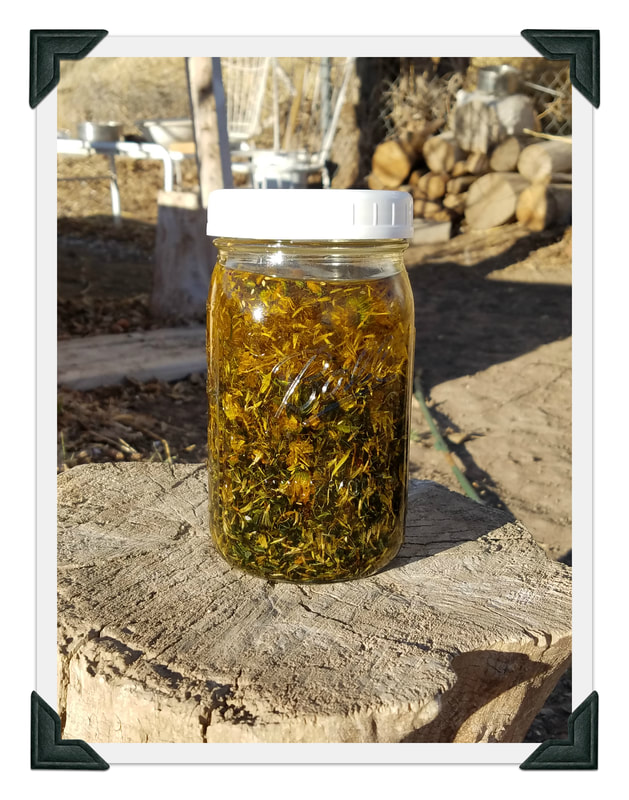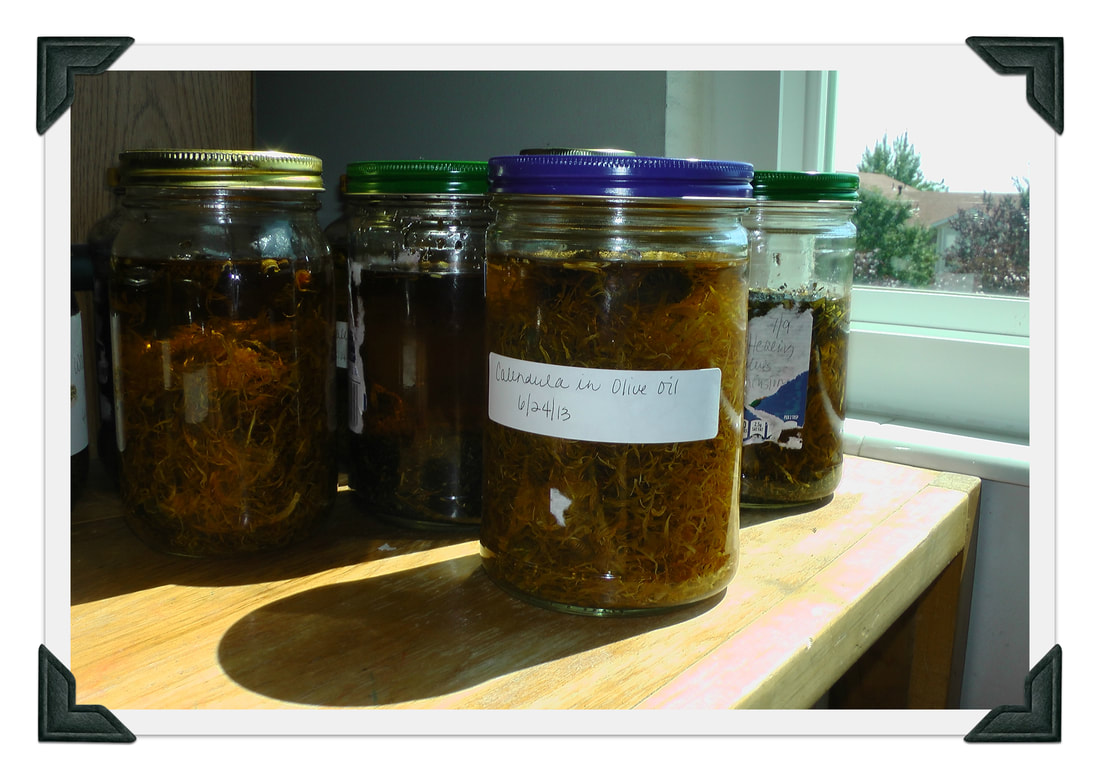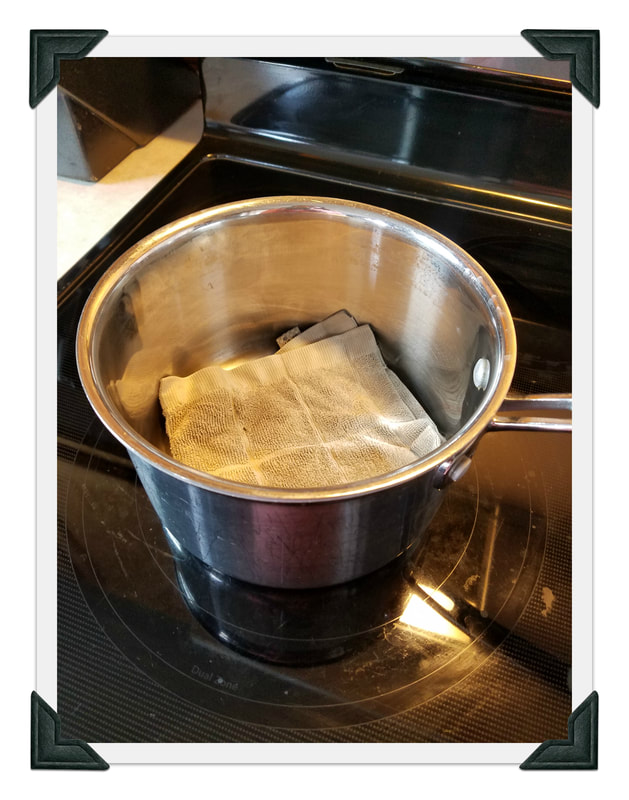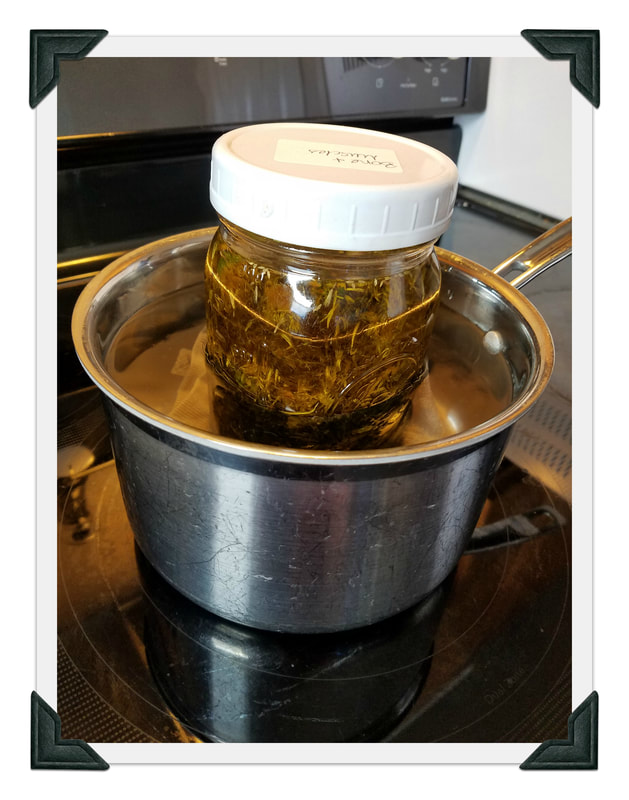INGREDIENTS
Fresh Herbs v.s. Dried
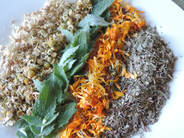
You can use either fresh, dried or even a combination of both when making an herbal infused oil. There are a couple of differences in how you prepare the herbs for infusion. When using fresh, let them dry wilt for a few hours to remove some of the moisture. For herbs that have a lot of moisture, such as comfrey and chickweed, use the dry plant method only. Too much moisture will cause the oil to go bad quickly. Finely chop them, then fill a jar 3/4 full of herb.
If using dried herb, blend to a powder so there is more surface area to pull from.
If using dried herb, blend to a powder so there is more surface area to pull from.
Oil
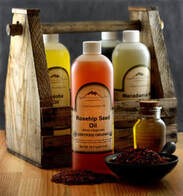
You can use any type of oil to infuse your herbs in and what you choose may depend on what you want to achieve. Some of the factors in differing oils are the weight; some are heavy, some light, some solidify at room temperature; shelf life, some oils go rancid quicker than others; healing properties, each oil has its own set of healing properties and functions that can play into the overall product. My favorite oil of choice, is Extra Virgin Olive Oil, it has a long shelf life and full of nutrients and skin soothing properties. Other commonly used oils are; coconut (which will solidify), sweet almond, grape seed and sesame oil. You can find a list of different oils and their properties and uses here.
100 Proof Vodka
This is an amazing tip I learned from Kami McBride, author of The Herbal Kitchen. By adding a small amount of alcohol to the herbs, they extract more plant constituents and preserve the oil longer.
HOW TO
The first step is to prepare the herbs for the best possible extraction by adding the 100 proof Vodka. Use two-parts (dry ounces) of herb to one-part (liquid ounces) Vodka. Mix thoroughly until a ball can be formed, you may need to adjust the liquid ratio if it falls apart. This is an optional step but one I have seen amazing results with. Place in a glass jar or bowl and cover with an air tight lid overnight.
Next we are going to extract the oil using a variety of methods that you can choose from, so check them out and find what works best for you. My personal favorite and the one I mainly use is the blender method. It is way more potent than any oil I've made before and only takes a couple of days!
Increments:
1 part herb
7 parts oil (you may need to adjust this amount to keep the oil covering the plant material completely)
Next we are going to extract the oil using a variety of methods that you can choose from, so check them out and find what works best for you. My personal favorite and the one I mainly use is the blender method. It is way more potent than any oil I've made before and only takes a couple of days!
Increments:
1 part herb
7 parts oil (you may need to adjust this amount to keep the oil covering the plant material completely)
Blender Method
I learned this method from Kami McBride and haven't look back to the other methods since.
Add the herbs and oil to a blender. Blend on high speed until the jar feels warm to the touch. Repeat several times a day for two days.
Add the herbs and oil to a blender. Blend on high speed until the jar feels warm to the touch. Repeat several times a day for two days.
Cold/Solar Infused Oil
|
Choose your herbs and follow the method for preparing them as outlined above. Once your jar is filled with herbs, pour your, high quality, oil of choice over the herb up to the top of the jar. Place a lid on the jar for dried herbs or a coffee filter or cheesecloth fastened with an elastic or canning ring, for fresh herbs. This allows the moisture left in the herbs a place to evaporate. Label the jar and place on a counter for 4 weeks, shaking each day for a cold infusion. For a solar infusion place outside in the sun, or even on a window sill that gets a lot of sun coming in. Leave the jar for two weeks or so, gently swishing it around each day (if you remember;).
|
Hot Extract Oil: Stove Method
|
Prepare your oil as above and place the jar in a pan of water with a towel or rag on the bottom to prevent your jar from breaking. Next fill the pan with water to where the herbal infusion starts or to just below the top of your pan, depending on how big the pan is. Bring the water to a soft simmer on low heat and let the oil sit in the simmer water for a minimum of 4-5 hours and up to 72 hours, swishing it gently every once in a while and keeping the water filled as it evaporates.
|
Hot Extract Oil: Slow Cooker Method
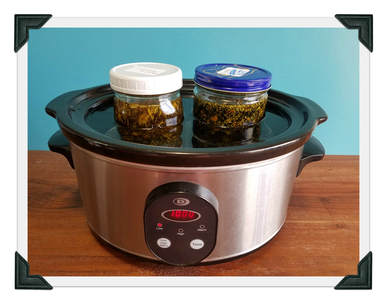
I love this method the best for hot extraction, not only do you not have to worry about watching the stove, you can fit two to three jars in at one time. Line your slow cooker with a towel, just like we did for the stove method. Place in your jars and then fill the crock pot up to the top with water. Set on low for 2-3 days, keeping the water filled to the top. My cooker only does 10 hours of slow cooking and switches to warm, which is fine, but I just restart the time on low and go the full 3 days.
Simmer Method
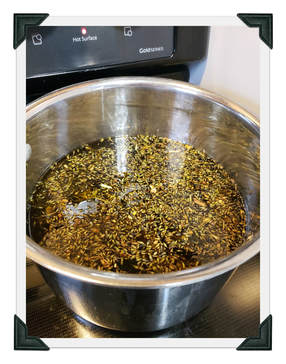
Place herbs in a pan with enough olive oil to cover the herbs. Turn the heat on low until it begins to simmer. Let simmer for a few minutes, and then remove from heat. Let cool. Strain herbs from oil. Be careful with this method because you do not want to burn your oil or herbs. Watch carefully and go by smell. You can also use a double boiler by placing the herbs and oil in the top part of the boiler. Slowly bring the oil to a very low simmer, you want the temperature to be between 95 and 110 degrees. Simmer for 30-60 minutes, making sure the oil is not overheating. The oil should turn the color of the herbs and smell potent. Strain the herbs and bottle the oil as above.
This is my least favorite method because the oil will go rancid more quickly than the other methods and there is more risk of burning the plant material.
Strain and Label
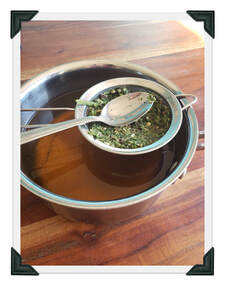
Once your oil is done macerating, you want to strain the herbs out of the oil with a strainer, cheesecloth or any other device you may come up with for separating the oil from the herbs. Don't squeeze the oil out of fresh herbs. This will allow moisture to enter your oil which will make it go rancid faster. Squeeze away with dry material. Using cotton muslin helps strain even the smallest of particles from the oil.
Store in a glass container with a label of the herbs you infused and the oil used. Store in a cool, dark location where your oil should last from several months to a year. When the oil loses its color and starts to smell rancid, you know it has gone bad and need to discard. You can now use your oil in cooking, as a massage oil, a liniment, an ointment for the eyes and ears, a wound dressing, nasal application, bath oil and beauty products, or turn it into a salve.
Store in a glass container with a label of the herbs you infused and the oil used. Store in a cool, dark location where your oil should last from several months to a year. When the oil loses its color and starts to smell rancid, you know it has gone bad and need to discard. You can now use your oil in cooking, as a massage oil, a liniment, an ointment for the eyes and ears, a wound dressing, nasal application, bath oil and beauty products, or turn it into a salve.

